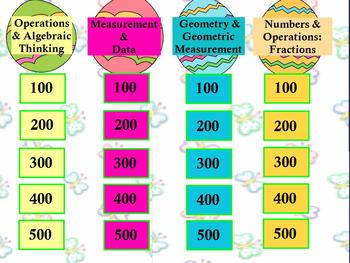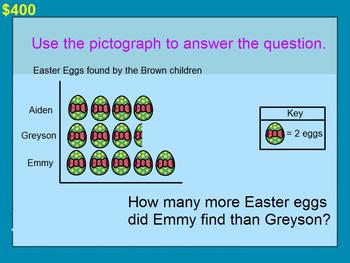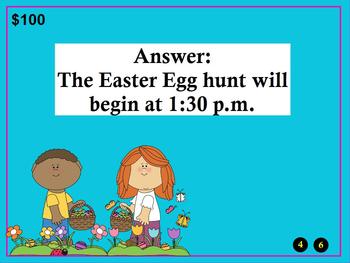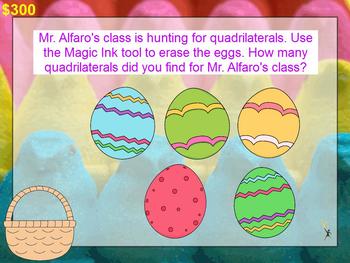3rd Grade Math Q & A Game~ CCSS Promethean/ClassFlow Spring / Easter Theme
Flip Charts Galore
1.2k Followers
Grade Levels
2nd - 3rd, Homeschool
Subjects
Resource Type
Standards
CCSS3.MD.A.1
CCSS3.OA.A.1
CCSS3.NF.A.1
CCSS3.G.A.1
Formats Included
- Flipchart File
Pages
45 pages
Flip Charts Galore
1.2k Followers
Description
Third Grade Math Jeopardy Promethean Flip chart game fully aligned with the Common Core State Standards. This game covers the strands of Operations & Algebraic Thinking; Number in Base Ten: Fractions; Geometry and Geometric Measurement and Measurement and Data.
Fun, interactive four-category game with score boards to cover and engage students in their learning.
Perfect review for State Testing and Test Prep.
Jeopardy games are the perfect way to engage students in their learning, review material, and do quick whole class pre- and post-assessments. I can make you a Jeopary game board for your smart or active board on just about any topic you would like.
Thank you to www.mycutegraphics.com for providing free and cute clip art for teacher use! Check out their site today!
Please feel free to send any questions you may have and I would love more followers if you are happy with this product :)
Fun, interactive four-category game with score boards to cover and engage students in their learning.
Perfect review for State Testing and Test Prep.
Jeopardy games are the perfect way to engage students in their learning, review material, and do quick whole class pre- and post-assessments. I can make you a Jeopary game board for your smart or active board on just about any topic you would like.
Thank you to www.mycutegraphics.com for providing free and cute clip art for teacher use! Check out their site today!
Please feel free to send any questions you may have and I would love more followers if you are happy with this product :)
Total Pages
45 pages
Answer Key
Included
Teaching Duration
N/A
Report this resource to TPT
Reported resources will be reviewed by our team. Report this resource to let us know if this resource violates TPT’s content guidelines.
Standards
to see state-specific standards (only available in the US).
CCSS3.MD.A.1
Tell and write time to the nearest minute and measure time intervals in minutes. Solve word problems involving addition and subtraction of time intervals in minutes, e.g., by representing the problem on a number line diagram.
CCSS3.OA.A.1
Interpret products of whole numbers, e.g., interpret 5 × 7 as the total number of objects in 5 groups of 7 objects each. For example, describe a context in which a total number of objects can be expressed as 5 × 7.
CCSS3.NF.A.1
Understand a fraction 1/𝘣 as the quantity formed by 1 part when a whole is partitioned into 𝘣 equal parts; understand a fraction 𝘢/𝑏 as the quantity formed by 𝘢 parts of size 1/𝘣.
CCSS3.G.A.1
Understand that shapes in different categories (e.g., rhombuses, rectangles, and others) may share attributes (e.g., having four sides), and that the shared attributes can define a larger category (e.g., quadrilaterals). Recognize rhombuses, rectangles, and squares as examples of quadrilaterals, and draw examples of quadrilaterals that do not belong to any of these subcategories.





